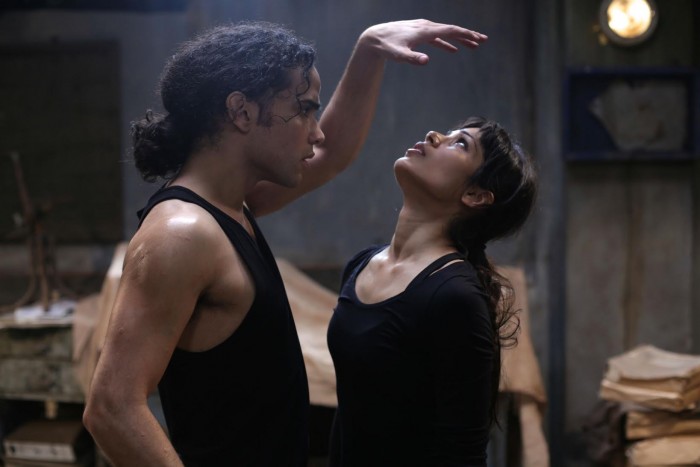
Editor’s disclosure: “Desert Dancer” was co-produced by one of the contributor’s relatives.
It is through beautifully choreographed dance sequences between young Iranian Afshin Ghaffarian (played by Reese Ritchie) and his love interest Elaheh (Freida Pinto) that we enter the Iranian youth’s struggle in “Desert Dancer,” which premieres in Seattle today.
As a true story of a young Iranian’s determination to pursue an art form largely banned in his country, we see a young Ghaffarian secretly watching footage of Russian ballet dancer Rudolph Nureyev in Mashhad, and follow him to the University of Tehran, where friends introduce him to YouTube via proxy server. The world of contemporary dance finally opens up for him.
He uses the videos to train with his friends, but that isn’t enough. He wants to perform and feel “free,” so they swallow the risk and put on a clandestine performance for other students in the desert: a high point in the film. But Ghaffarian still decides to escape to Paris from Tehran after being captured and beaten by the Revolutionary Guard during the 2009 presidential election demonstrations.
Most American-made films about Iran such as “Argo” and “Not Without My Daughter” take a broad-brush, politically-laced approach in depicting Iranians as hostile — even barbaric.
British director Richard Raymond wanted to tell a “universal” story with “Desert Dancer.”
“I thought that ‘Desert Dancer’ was an opportunity to actually shine a positive light on Iran in the sense … that it’s a film that isn’t political in any way,” he told CNN. “It’s a film about the people and the heroes of Iran who are the youth of Iran, who exist artistically despite all the restrictions placed among them.”
But has Raymond equated “positive” with depicting Iranians as Westerners? And does the film do its job in providing enough context about Iran?
As one audience member remarked after a “Desert Dancer” screening I attended last weekend, “I still don’t know why dance is banned in Iran.”
Raymond may well respond, “Does it matter?”
But according to Ali Rouhfar, an Iranian-American calligraphy artist based in Seattle, it does. Artistic responsibility to inform — especially with film — should be a consideration.
“Film is the best connection for the culture,” he said. “I think that Americans should know Iranians. After 9/11, they didn’t know the difference between Iraqis, Afghanis, Iranians and Indians.”
For safety reasons, neither Raymond nor the principal actors visited Iran, so “Desert Dancer” was shot in Morocco in English.
Despite a missed opportunity to inform largely ignorant American audiences about Iran, the film does have its highlights.
Cinematically the film is beautiful, accompanied by an inspirational soundtrack, and Iranian production designer Shahram Karimi did a skillful job.
Pinto’s fragile and complex character also rises to the occasion with some very touching scenes linking her heroin addiction to her ballerina mother’s descent after dance was banned in post-revolutionary Iran.
As the daughter of an Iranian mother who still grieves her traumas in pre-revolutionary Iran, I found this storyline and relationship added depth to the story.
However, the extent of the broader political and social nuance delivered in the film was limited. Outside of the dancing scenes, the youth in the film were shown either high on heroin, raving at underground techno parties or reading Western literature (aside from the one reading of a Rumi poem). They wanted to escape to the “free” West.
Having visited young people in Tehran in the summer of 2008 for my first reporting trip, I did meet youth who were outward-looking and desiring self-expression, but they were also highly educated and career-focused. Above all, they loved their country and its ancient and poetic culture.
So if they did leave, it was usually with mixed feelings.

Back in Iran, people live in tightly-knit communities, meaning they rarely face problems alone unlike the more individualistic and isolated lives we live in the West.
But “Desert Dancer” reduces being a citizen of Iran to being kicked while on the ground: the opening scene to the film. Further depictions of Iran’s government consist of showing the police as outlaws beating up youth in back alleys or the Revolutionary Guard driving them out to the desert with bagged heads and guns to their temples.
I’m not saying the regime is gentle — far from it — but a system and courts of law do exist in Iran, believe it or not.
After four years of reporting on Iran and Iranian communities from Tehran, to London and Paris, as well as Erbil, Kurdistan and Northern Iraq, it is clear to me that Raymond gives us a more stereotypical American portrayal. In reality, they probably would have been taken to jail and questioned or tortured there.
“Desert Dancer” is not a documentary, so why should it provide accurate context, or even answer our dear audience member’s question about why dance is banned in Iran?
Well, Ayatollah Khomeini banned dance after the Revolution back in 1979 (male folk dance is now permitted) because of an Islamic Hadith which calls entertainment “frivolous’” So viewed through this religious paradigm, it wasn’t intended to limit freedom of expression, but preserve chastity and good Muslim behavior.
Iran is a complex society, and in the end, it hinders the film creatively not to provide this insight. As A.V Club’s Katie Rife insightfully points out, “by trying to cater to a Western audience, the filmmakers end up with an Iran neither foreign nor familiar.”
In the end, Iranians already know Americans, but Americans still don’t really know Iranians.


My wife and I really was looking forward to see desert dancer this weekend but was deeply heart broken to find out that it is no longer in theaters. Why wasn't in theaters longer. My wife and I are both dancers and was moved by the trailer. When can I see it on video or anything.